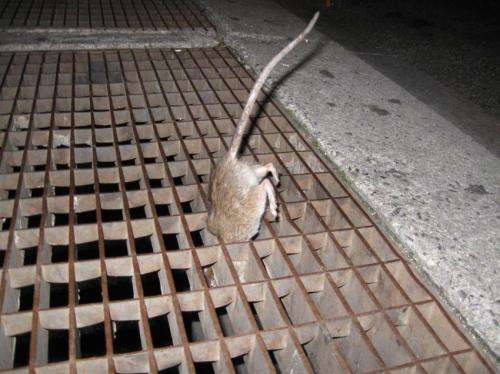Disease-carrying fleas abound on New York City's rats

In the first study of its kind since the 1920s, rats in New York City were found to carry a flea species capable of transmitting plague pathogens.
In research appearing March 2 in the Journal of Medical Entomology, lead author Matthew Frye, an urban entomologist with Cornell University's New York State Integrated Pest Management (IPM) Program, reported collecting more than 6,500 specimens of five well-known species of fleas, lice and mites from 133 rats. Among them: 500-plus Oriental rat fleas, notorious for their role in transmitting the bubonic plague, also known as the Black Death.
The Cornell and Columbia University research team looked most closely at the rat flea because of its potential as a vector for human diseases.
"If these rats carry fleas that could transmit the plague to people, then the pathogen itself is the only piece missing from the transmission cycle," says Frye.
Where is the plague found these days? In the U.S., it's found in the American Southwest among ground squirrels, prairie dogs and the fleas they harbor, infecting roughly 10 people each year. In other parts of the world, the incidence of plague is higher.
The plague wasn't the only disease of concern. Co-author Cadhla Firth, a research scientist at Columbia University's Center for Infection and Immunity, and her colleagues used molecular screening methods to look for two other pathogenic bacteria the Oriental rat flea could vector: Rickettsia (which they didn't find) and several species of Bartonella.
"These pathogens can cause a wide range of clinical syndromes, some severe," says Firth.
The study's results suggest that public health officials closely monitor city rats and the fleas that call them home. But everyone can contribute, Frye says, by implementing IPM practices. "Removing food and water and preventing access to shelter are key to knocking back rodent infestations," he says.
When we evict rats from our homes and workplaces, we need another core IPM practice - careful sanitation. It's critical to rid buildings of the fleas, lice and mites that are left behind. "It's not that these parasites can infest our bodies," Frye says, "but they can feed on us while seeking other rats to infest."
In research published in 2014 in the journal mBio with Firth as lead author, the scientists noted a disturbing number of viral and bacterial diseases that those same 133 rats carried. Some were unknown until now, including a handful that could infect humans.














